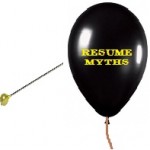 Everyone seems to have their opinion on what should, or shouldn’t be included in a résumé, and in today’s article, I debunk some of the prevailing myths about résumés that could be potentially hurting your prospect of securing an interview and in turn your dream job.
Everyone seems to have their opinion on what should, or shouldn’t be included in a résumé, and in today’s article, I debunk some of the prevailing myths about résumés that could be potentially hurting your prospect of securing an interview and in turn your dream job.
Myth One -A résumé is about YOU
If you think your résumé is about YOU, you need to start thinking about this document in a whole new light. NO a résumé is not about YOU, it is about what YOU can offer THEM! , that is the employer, recruiter, agency and selection panel members, if applying for a government position.
Myth Two – Résumés should be limited to 1 or 2 pages
The standard in résumé in Australia is longer than the standard resume in the UK, or America. So ignore job search sites that advise you to limit your résumé to one or two pages, as usually these are American or UK sites where the recruiting practices are different from those prevalent in Australia.
Instead, focus on a résumé that truly reflects your skills and experience and even if this takes five pages, so be it (unless a page limit is imposed by the employer). HOWEVER, make sure you don’t waffle, and don’t include information that is not required, repetitive, or irrelevant.
NOTE: The average length of a résumé in Australia is usually anything between three and four pages.
Myth Three – A résumé should include a strategic objective
Career objectives, don’t work. Why? Because a career objective is entirely focussed on YOUR needs, rather than the employers! Since the most effective résumé is focussed on the potential employers needs, why focus the prime real estate space of your document on what you want! (That visual centre, 1/3 down on your 1st page of your résumé, is where the employer will typically stop first, so this is where you should pack your biggest punch!)
A better alternative is to include a profile, an introduction or qualifications and experience summary. That way you can really provide focus on the value that you offer the employer. This critical, but subtle difference might just result in you securing an interview.
Myth Four – Content is more important than formatting
Yes content is KING – but equally important is the formatting of your document. Your document should be visually appealing, in the same way company’s package their goods in a way to enhance their appeal for buyers.
When formatting your résumé, make sure you DON’T use templates from the major job search sites. Literally thousands of job seekers use these templates and if you are in the business of recruiting people, you know straight away the origin of the template and these online templates don’t make a good first impression!
Myth Six – Don’t ever include personal data
This key myth is both true and false. It is true in that there is a large trend away from providing any personal details, such as date of birth and marital status. However there are exceptions to this rule.
For the bulk of job seekers, you should NOT include personal data, since the purpose of a résumé is to screen candidates out, not in. While in Australia, there is a raft of legislation protecting candidates – by including personal information, you could unnecessarily place yourself in a position of being ‘pigeon holed’ by employers and selection panel members, or indirectly discriminated against. So leave the following details out of your résumé:
- Date of birth
- Martial status and number of children
- Photographs, no matter how photogenic you are
- Personal data, such as health status, height and weight
- Interests and hobbies
- Photocopied written references attached at the end of your résumé. Save these for the interview, unless specifically requested in the application form.
However, ignore this rule, if these personal attributes will enhance your application. The exceptions to this rule, is as follows:
- If you are an Indigenous Australian, it would be beneficial to include this personal detail, if the organisation or government agency is running an Aboriginal employment plan.
- If applying for an entry level training position that is targeting disadvantaged groups, include all your personal details that address their selection priorities, in particular age and ethnic background.
- Use your interests to enhance your application, if your interests and hobbies reinforce your passion or capacity to do the job. For example, including hobbies relating to looking after wildlife, if applying for a conservation traineeship, or listing your sporting achievements and interests, if applying for a job in which high levels of fitness are a requirement.
- Include your photograph, height and so on, if this is a requirement of the employer. For example a portfolio for models, or an application for a major airline.
Now that I have debunked some of the key myths surrounding the Australian résumé, you can write an employer-focused résumé for the Australian market place that will get your readers attention, generate interest and position you above your competition – including those who may be more qualified than you.
 Get exclusive content when you subscribe to Boost Your Career
Get exclusive content when you subscribe to Boost Your Career Carolyn Smith BA, LLB, PLSC, CARW, CEIC, CERW
Carolyn Smith BA, LLB, PLSC, CARW, CEIC, CERW
Leave a Reply